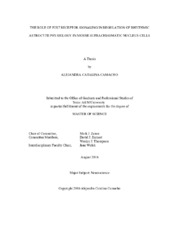| dc.description.abstract | Mammalian circadian rhythms are controlled by the suprachiasmatic nuclei (SCN) of the hypothalamus. While neural circuits influence SCN entrainment, cells within the SCN also act as individual oscillators. Research on mechanisms that regulate synchronization of ensemble SCN rhythms has mainly focused on neuronal populations. However, astrocytes are just as abundant in the SCN and display circadian rhythms in clock gene expression and extracellular accumulation of ATP. Rhythmic accumulation of ATP in the rat SCN in vivo has also been described to occur during the night. Nonetheless, it remains unclear whether or not astrocytic ATP release functions as a synchronizing signal in the SCN and contributes to ensemble neural activities such as inflammatory signaling. Preliminary studies on SCN cell cultures and purinergic inhibitors disrupt ATP accumulation and clock gene expression rhythms. Further, clock-defective astrocytes are unable to accumulate ATP rhythmically. I tested the hypothesis that ATP signaling mediates rhythms in astrocytic physiology through P2X7 receptor. First, I tested whether rhythmic ATP release may synchronize individual oscillators in the SCN cells. I also tested the effectiveness of BzATP, a P2X7R agonist, in inducing release of ATP in mouse SCN cells. I tested if P2X7R, GFAP overall protein expression and astrocytic activation markers such as GFAP, are rhythmic in mouse SCN cells. I demonstrate that ATP signaling among astrocytes is a good candidate for a coordinating mechanism that synchronizes clock-controlled physiological responses in the SCN and other brain regions. Furthermore, I present data indicating that clock-controlled ATP signaling rhythms are involved in modulating neuroinflammatory signaling. Since BzATP proved to be an effective P2X7R agonist with regard to potentiating ATP release from mouse SCN cells, further experiments with other agonists and antagonists can provide evidence for the role of ATP and P2X7R signaling rhythms, their circadian regulation, and their influence on astrocytic physiology and brain health. | en |


